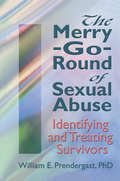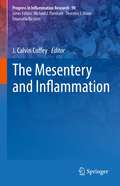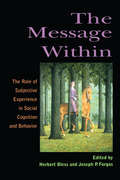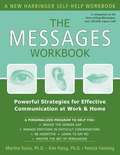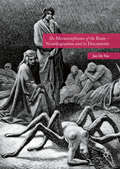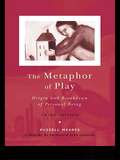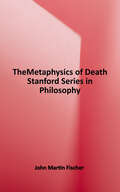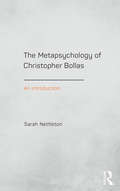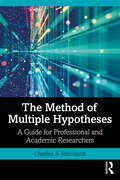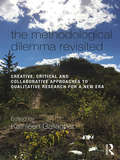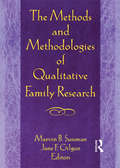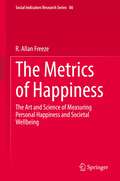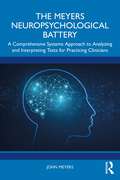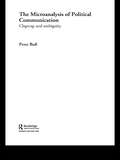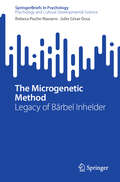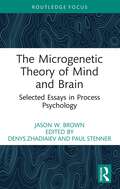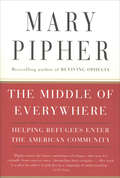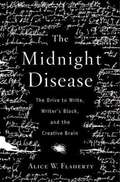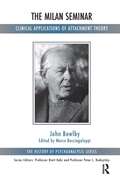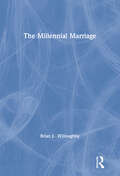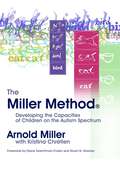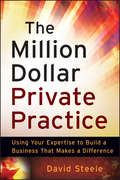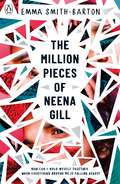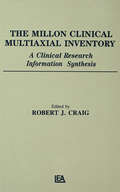- Table View
- List View
The Merry-Go-Round of Sexual Abuse: Identifying and Treating Survivors
by Letitia C Pallone William E PrendergastThe Merry-Go-Round of Sexual Abuse is a valuable guide to identifying, treating, and breaking the cycle of sexual abuse. Based on 30 years of professional experience in treating offenders and survivors of sexual assault and sexual molestation, Dr. Prendergast provides step-by-step guidelines and specialized treatment techniques most effective in producing change in this group of clients. Each technique is illustrated with pertinent case studies. This is a much-needed guide for professionals who often lack specific training in the identification and treatment of both offenders and survivors of sexual abuse.Prendergast identifies the survivors of sexual abuse, explores the “why sex” inquiry and discusses the characteristics of the abuser. Each topic is treated by first presenting a fact or principle which is then illustrated with a case study that exhibits the principle in practice. A broad range of topics essential to the treatment of offenders and survivors of sexual abuse are clearly explained in this book including: 18 factors to consider when working with survivors of sexual abuse behavioral effects of unresolved but consciously remembered sexual abuse and unidentified sexual trauma specialized interviewing techniques for survivors of sexual abuse specific treatment techniques for 4 different categories of sexual abuse--homosexual abuse (both seductive and assaultive), assaultive sexual abuse, incest, and long-term seductive sexual child abuse “self-confrontation” as a new therapy approach for survivors aftercare continuation and consistency therapist qualifications and cautionsThis book is an in-depth exploration of the topic, usually only touched on in college courses and graduate programs. It features treatment techniques that are not taught in schools or universities. Psychiatrists, psychologists, social workers, and counselors who are untrained in working with this specific group will benefit from these insightful discussions and specific case studies. The Merry-Go-Round of Sexual Abuse can easily be used as a complete training manual for practicing therapists as well as interns, trainees, and graduate students in the field of sexual abuse. In addition, police investigators, parents of either victims or abusers, significant others of survivors, survivors themselves, and the public in general will benefit from the understanding Prendergast offers on the problem of sexual abuse.
The Mesentery and Inflammation (Progress in Inflammation Research #90)
by J. Calvin CoffeyThe volume summarizes the most recent advances in our understanding of the mesentery and explains the how these are important in inflammation. It comprises a series of state of the art chapters by leading authorities in each area. It explains how recent advances in our understanding of the mesenteric organ, have advanced the diagnosis and treatment abdominal and systemic conditions including cancer, inflammatory bowel disease and endocrine conditions such as diabetes, and circulatory disorders such as atherosclerosis.
The Message Within: The Role of Subjective Experience In Social Cognition And Behavior
by Herbert Bless Joseph P. ForgasThis provocative book provides the first comprehensive and informative overview of the role of various subjective experiences in social cognition and behavior, and argues that the study of such experiences may be one of the key unifying themes of social psychology. Based on recent theoretical and empirical developments in the discipline, this select group of leading international researchers surveys extensive evidence and shows that subjective experiences play a key role in most aspects of social cognition and social behavior. The book contains five main sections, discussing the role of subjective experiences in social information processing (Part 1), their influence on memory (Part 2) and their role in intergroup contexts (Part 3). The role of affective experiences in social thinking and behavior is analyzed (Part 4), and the influence of subjective experiences on the development and change of attitudes and stereotypes is also addressed (Part 5).
The Messages Workbook: Powerful Strategies For Effective Communication At Work And Home
by Patrick Fanning Martha Davis Kim PalegSimply put, skill at communicating with others is the single largest determinant of anyone's happiness, and success. Rewarding and lucrative careers, strong and lasting friendships, meaningful and satisfying romance all hang on this one uniquely human ability. You need strong communication skills to survive. The better able you are to communicate with others, the happier and more successful you will be.
The Metamorphoses of the Brain - Neurologisation and its Discontents
by Jan De VosWhat are we exactly, when we are said to be our brain? This question leads Jan De Vos to examine the different metamorphoses of the brain: the educated brain, the material brain, the iconographic brain, the sexual brain, the celebrated brain and, finally, the political brain. This first, protracted and sustained argument on neurologisation, which lays bare its lineage with psychologisation, should be taken seriously by psychologists, educationalists, sociologists, students of cultural studies, policy makers and, above all, neuroscientists themselves.
The Metaphor of Play: Origin and Breakdown of Personal Being
by Russell MearesPersonality disorder can be conceived as the result of a disruption on the development of self. This thoroughly updated edition of The Metaphor of Play examines how those who have suffered such disruption can be treated by understanding their sense of self and the fragility of their sense of existence. Based on the Conversational Model, this book demonstrates that the play of a pre-school child, and a mental activity similar to it in the adult, is necessary to the growth of a healthy self. The three sections of the book - Development, Disruption and Amplification and Integration - introduce such concepts as the exceptional field, paradoxical restoration, reversal, value and fit, and coupling, amplification and representation. This highly readable and lucid presentation of the role of play in the development of self will be of interest not only to therapists but also to those interested in the larger issues of mind and consciousness.
The Metaphysics of Death (Stanford Series in Philosophy)
by John Martin FischerThis collection of seventeen essays deals with the metaphysical, as opposed to the moral, issues about death. For example, the authors investigate (among other things) the issue of what makes death a bad thing for an individual, if indeed death is a bad thing.
The Metapsychology of Christopher Bollas: An Introduction
by Sarah NettletonThe Metapsychology of Christopher Bollas: An Introduction explores Bollas’s extraordinarily wide contribution to contemporary psychoanalysis. The book aims to introduce and explain the fundamentals of Bollas’s theory of the mind in a systematic way, addressing many of the questions that commonly arise when people approach his work. Through chapters on topics such as the receptive subject, the creative unconscious and the implications of Bollas’s metapsychology for the technique of free association, the book enables the reader to acquire an understanding of his unique psychoanalytic language, to grasp the conceptual building blocks of his thinking and how these interrelate, and to appreciate the theoretical and clinical coherence of his thinking. The Metapsychology of Christopher Bollas: An Introduction will be of use to psychoanalysts, psychotherapists and counsellors, as well as psychiatrists, psychologists and social workers wishing to explore the applications of psychoanalytic thinking to their practice. It will be of great value to trainees in these disciplines, as well as to postgraduate students and academics interested in contemporary psychoanalysis.
The Method of Multiple Hypotheses: A Guide for Professional and Academic Researchers
by Charles S. ReichardtThis book illustrates the method of multiple hypotheses with detailed examples and describes the limitations facing all methods (including the method of multiple hypotheses) as the means for constructing knowledge about nature. Author Charles Reichardt explains the method of multiple hypotheses using a range of real-world applications involving the causes of crime, traffic fatalities, and home field advantage in sports. The book describes the benefits of utilizing multiple hypotheses and the inherent limitations within which all methods must operate because all conclusions about nature must remain tentative and forever subject to revision. Nonetheless, the book reveals how the method of multiple hypotheses can produce strong inferences even in the face of the inevitable uncertainties of knowledge. The author also explicates some of the most foundational ideas in philosophy of science including the notions of the underdetermination of theory by data, the Duhem-Quine thesis, and the theory-ladenness of observation. This book will be important reading for advanced undergraduates, graduates, and professional researchers across the social, behavioral, and natural sciences wanting to understand this method and how to apply it to their field of interest.
The Methodological Dilemma Revisited: Creative, Critical and Collaborative Approaches to Qualitative Research for a New Era
by Kathleen GallagherIn The Methodological Dilemma Revisited, authors examine what in their research processes has given pause, thwarted the process of seamless productivity, or stalled the easy research output but has, instead, insisted upon a deeper analysis. This resistance of the expedient explanation has consequences both for the research topics under study and the ways in which qualitative research is conducted in a globalized era of deepening social inequality. The book is pedagogical in its orientation and reflects upon the politics of knowledge construction. Working with queer and minoritized youth communities, and other precarious publics, the authors convey their relationships to groups they are inside or outside of, or allied with—posing ethical questions about research designs and worldviews. Themes such as representation, refusal, and resistance of hegemonies are nuanced by investigations into the ethical, practical, and scholarly dimensions of the turn toward collaboration in qualitative inquiry. Other chapters examine the place, value, and concerns of aesthetic representation of qualitative research. Finally, the authors consider issues of criticality in research, and the concepts of compassion and humility. This book contains contributions from some of the most imaginative qualitative researchers, making the most of their research dilemmas in order to reflect upon the challenges and resistances they encounter in the work of qualitative research.
The Methods and Methodologies of Qualitative Family Research
by Marvin B Sussman Janet F GilgunThe Methods and Methodologies of Qualitative Family Research can provide you with a strong conceptual framework for undertaking qualitative research. As it explores inquiry and theory on the cutting edge, it shows how qualitative methodologies can be applied to family life, education, and research. Designed to demonstrate how emerging and established methodologies can advance the understanding of families and direct social change, this book is a major step in assessing the development, progress, and contributions of qualitative inquiry. Packed with useful information and innovative approaches, this volume pulls together a rich and diverse group of essays that teach readers about the complexities and challenges of qualitative research. Most importantly, you’ll learn how new qualitative approaches are grounded in systems thinking, holistic formulations, attention to context, cultural sensitivity, and nonlinear dynamics.The Methods and Methodologies of Qualitative Family Research is distinct from other books of its kind because it acknowledges the agent, or self, in compiling data and reaching conclusions. Moreover, it analyzes how studying the world affects those doing the studying and how those effects, in turn, play a substantial role in interpreting data and forming conclusions. The Methods and Methodologies of Qualitative Family Research introduces three major types of qualitative clinical family research: conversational analysis, recursive frame analysis, and hermeneutic phenomenology. It exposes a wide array of resources for undertaking qualitative inquiry, including data journals, letters, official files, clinical case notes, folk tales, interviews, and field observations. You’ll learn how these resources are invaluable tools for understanding: couples’decisionmaking generative fathering reflexivity the use of historical data to construct composite cases egalitarianism and oppression in marriage perceptions of gender, race, and class among African-American adolescent women successful aging among individuals who require long-term care poverty and access to servicesA skillful blend of theory and practice, The Methods and Methodologies of Qualitative Family Research offers conceptual schemes, bibliographies, and other useful resources for teaching and conducting qualitative research. It will revolutionize the way you think about qualitative inquiry and your own approaches to qualitative family research. In addition, you’ll come away updated on the current state of qualitative research and with new skills and techniques for tackling your own research.
The Metrics of Happiness: The Art and Science of Measuring Personal Happiness and Societal Wellbeing (Social Indicators Research Series #86)
by R. Allan FreezeThis book provides a comprehensive treatment of how happiness and wellbeing are measured. It presents an accessible summary of the philosophy, methodology, and applicability of the various measurement techniques that have been generated by the leaders of the happiness movement. It traces the history of development of the core ideas, and clarifies the unexpectedly wide range of techniques that are used. The book provides an unbiased assessment of the strengths and weaknesses of each approach and differentiates the contributions that have been made by psychologists, economists, environmentalists, and health scientists. It examines applications at a personal scale, in the workplace, at a societal scale, and on the world stage. It does so in an easy-to-read anecdotal writing style that will appeal to a wide range of academic and lay readers who enjoy popularized non-fiction that address matters of social concern.
The Meyers Neuropsychological Battery: A Comprehensive Systems Approach to Analyzing and Interpreting Tests for Practicing Clinicians
by John MeyersThis book presents detailed information on the Meyers Neuropsychological Battery (MNB) and the statistical system used to interpret the neuropsychological data patterns. By using the statistical methods a more consistent and appropriate interpretation can be made. This book contains information on normative data, performance validity, ecological validity, calculating strengths and weaknesses, comparison groups, and premorbid estimates as well as the statistical methods used with the MNB.The validity and reliability of the MNB as well as the ecological validity are all explained. Another area of detailed explanation is performance validity measures. This includes false positive rates as well as frequency of failures and passing rates for each individual performance validity measure. The statistical methods for group comparisons are demonstrated, which provides the reader with clear examples of how to apply the statistical methods to any test results. Answers are given for many of the questions asked about the MNB and the statistical methods. A modified Rohling's interpretive method is incorporated into the MNB, and demonstrates the benefit this model brings to data interpretation and practical application.This book will be an invaluable tool for clinical neuropsychologists, and all who assess and treat patients with cognitive impairment. The book is also for forensic neuropsychologists who wish to use an objective and consistent interpretive method, and lawyers and judges who wish to understand neuropsychological data and assessment.
The Microanalysis of Political Communication: Claptrap and Ambiguity (Routledge Research International Series in Social Psychology #Vol. 7)
by Peter BullThis analysis of political speeches and televised political interviews in the UK, based on the Annual Party Conferences (1996-2000) and the last five general elections (1983-2001), evaluates the interview skills of politicians and political interviewers, investigates how and why politicians equivocate and handle interruptions and examines the nature of applause, both invited and uninvited, in political speeches.
The Microgenetic Method: Legacy of Bärbel Inhelder (SpringerBriefs in Psychology)
by Rebeca Puche-Navarro Julio César OssaOne of the arguments that explain the relevance of this book is the overwhelming lack of knowledge that the current literature throws on the Inhelderian microgenetic method. The place of this method is definitely ungrateful and has remained incomprehensibly hidden. All indications are that it seems to have lagged behind many of the brightest heads in developmental psychology, those who made up the Geneva school. The book aims to illustrate how Inhelderian microgenesis emerges in the landscape of cognitive development as a new object of study. More than ruptures with respect to the problems of the normative subject, the Inhelderian project entails both conceptual and methodological displacements. In this new map, the psychological subject takes a predominant place, and does so in terms of the cognitive functioning of the subject in relation to situations of resolution. This functioning is studied on the basis of the microgenetic method, which makes it possible to identify the role of mental schemas, their combinations and recompositions in the face of specific and problematic situations. The totally original version of the microgenetic method that is delivered from the Inhelderian legacy in this book, not only recovers its basic sense but also advances in the direction of some indications that Inhelder herself had pointed out. This renewed object of study recovers a subject, with a status in terms of its own models, its theories and its dynamics. Starting from a demanding and knowledgeable reading of Inhelder's work. This knowledge becomes the best criterion to point out an updated path of the work with concepts and tools resulting from recent research but articulated with a microgenetic vision coming from the most orthodox tradition. The bet consists of advancing from the legacy of Inhelder and her team and projecting it as a methodological alternative for current research in developmental studies.
The Microgenetic Theory of Mind and Brain: Selected Essays in Process Psychology
by Jason W. BrownThis book asks where ideas, objects and feelings come from and how they arise via an exploration of the nature of subjective experience and its relation to the world. Seeking an explanation for the experience of subjective duration and the present and in contrast to the conception of mental events as non-temporal logical solids, it explores a diachronic processual theory founded on psychological data and clinical observation that provides an explanatory “system” of thought adequate to the phenomena it is called on to explain. The author focuses on the intra-psychic sources and nature of subjective experience, with the intent of examining a variety of phenomena from the standpoint of microgenetic theory. The chapters deal with the origins of human subjectivity and the epochal nature of time and duration, change and the relevance of a theory of the mental state to dream and the waking present. Based on speculative psychology that flows from case studies in neuropsychology and concepts in process philosophy, it advances a theory of mind and brain that brings together previous, fragmentary research studies on this topic.
The Middle of Everywhere: Helping Refugees Enter the American Community
by Mary PipherThe bestselling author of Reviving Ophelia and Another Country profiles refugees from around the world who emigrate to the United States.In cities and towns all over the country, refugees arrive daily. Lost Boys from Sudan, survivors from Kosovo, families fleeing Afghanistan and Vietnam: they come with nothing but the desire to experience the American dream. Their endurance in the face of tragedy and their ability to hold on to the essential virtues of family, love, and joy are a tonic for Americans who are now facing crises at home. Their stories will make you laugh and weep—and give you a deeper understanding of the wider world in which we live.The Middle of Everywhere moves beyond the headlines, into the hearts and homes of refugees from around the world. Her stories bring to us the complexity of cultures we must come to understand in these times. &“Pipher enters the hearts and homes of refugees who now live virtually from coast to coast, chronicling their struggles…. Her work is a plea for others to join her in a campaign of understanding.&”—USA Today&“Pipher unites refugees, people who have fled some of the most oppressive regimes in the world, with all of us…. [She] is taking this moment to teach us un-American behaviors: Patience, manners, and tolerance.&”—Milwaukee Journal Sentinel&“Drawing upon anthropology, sociology and psychology, [Pipher] offers a deft, moving portrait of the complexity of American life…Pipher's ambitious undertaking of combining personal stories with global politics is wonderfully realized.&”—Publishers Weekly (starred review)
The Midnight Disease: The Drive to Write, Writer's Block, and the Creative Brain
by Alice W. Flaherty&“An original, fascinating, and beautifully written reckoning . . . of that great human passion: to write.&”—Kay Redfield Jamison, national bestselling author of An Unquiet Mind Why is it that some writers struggle for months to come up with the perfect sentence or phrase while others, hunched over a keyboard deep into the night, seem unable to stop writing? In The Midnight Disease, neurologist Alice W. Flaherty explores the mysteries of literary creativity: the drive to write, what sparks it, and what extinguishes it. She draws on intriguing examples from medical case studies and from the lives of writers, from Franz Kafka to Anne Lamott, from Sylvia Plath to Stephen King. Flaherty, who herself has grappled with episodes of compulsive writing and block, also offers a compelling personal account of her own experiences with these conditions. &“[Flaherty] is the real thing . . . and her writing magically transforms her own tragedies into something strange and whimsical almost, almost funny.&”—The Washington Post &“This is interesting, heated stuff.&”—San Francisco Chronicle &“Brilliant . . . [a] precious jewel of a book . . . that sparkles with some fresh insight or intriguing fact on practically every page.&”—Seattle Post-Intelligencer &“Flaherty mixes memoir, meditation, compendium and scholarly reportage in an odd but absorbing look at the neurological basis of writing and its pathologies . . . Writers will delight in the way information and lore are interspersed.&”—Publishers Weekly
The Midnight Disease: The Drive to Write, Writer's Block, and the Creative Brain
by Alice Weaver FlahertyNeurologist Flaherty (Massachusetts General Hospital and Harvard Medical School) explains the psychological and neuroscientific knowledge about the process of writing for a lay audience. She discusses the temporal lobe's role in "abnormal hypergraphia," an increased desire to write. She then explores psychological and neurological explanations for writer's block. The roles of the cerebral cortex in writing ability, the limbic system in the drive to communication, and the temporal lob in metaphorical thinking are examined in subsequent chapters. Annotation ©2004 Book News, Inc. , Portland, OR (booknews. com)
The Milan Seminar: Clinical Applications of Attachment Theory (The History of Psychoanalysis Series)
by John BowlbyThis edited book contains a hitherto unpublished seminar held by the author in Milan, Italy in 1985. The seminar is preceded by a foreword by Kate White, of the Bowlby Centre, and by an introduction by the editor, Marco Bacciagaluppi. The introduction contains excerpts from unpublished correspondence between the author and the editor, carried out over a span of eight years, between 1982 and 1990. After the seminar there are the follow-ups of the three cases presented by Leopolda Pelizzaro, Ferruccio Osimo and Emilia Fumagalli, and a report by Germana Agnetti and Angelo Barbato, who gave hospitality to the author and his wife. This is followed by a contribution by Ferruccio Osimo on experiential dynamic psychotherapy, an application of attachment theory, with a long case study. At the end there are some concluding remarks by the editor.
The Millennial Marriage
by Brian J WilloughbyThis essential text explores the concept of "Me-Marriage"—a marital relationship that blends individualized life goals and interests—and draws from research on the current benefits and costs of marriage to consider how to achieve success, both individually and relationally. Chapters explore the larger patterns at play and identify the trends about what a modern "healthy marriage" looks like for this new generation. Brian J. Willoughby combines a review of the latest social science research on the benefits and costs of marriage with new quantitative and qualitative data from married and single adults. The book explores how marriage has fundamentally shifted in the Western world due to the changing values and approaches to relationships by the Millennial generation that is now largely transitioning to marriage. This book is an ideal text for clinicians and practitioners (particularly those working with young married populations) looking for guidance on how to understand the increasingly complex ways that adults are navigating their relationship landscape, as well as students and scholars in the fields of psychology, family studies, and sociology and those interested in individual development, relational development, and demographic trends on the family.
The Miller Method (R): Developing the Capacities of Children on the Autism Spectrum
by Arnold MillerThis informative and practical guide to the Miller Method® presents an entirely new and dynamic perspective on advancing the body organization, social, and communicative skills of children diagnosed with autism spectrum disorders (ASDs). Working on the premise that children with ASDs learn more effectively when their whole bodies are involved, The Miller Method® covers major issues such as communication skills and social play, as well as day-to-day behavioral issues including tantrums, aggression and toilet training. Part of Miller's method includes guiding the child on to The Elevated Square, a device that gets the child off the floor and markedly diminishes toe-walking, hand flapping and aimless wandering. By creating a highly defined reality that requires the child's rapt attention to traverse it, the Elevated Square helps counter some of the significant challenges these children confront. Another feature of the method entails the carefully gauged disruption of everyday routines. This may include deliberately 'messing up' the classroom so that the children experience putting it together and learning that they can cope with disorder and change. This practical resource is essential reading for parents and professionals living and working with children with ASDs.
The Million Dollar Private Practice
by David SteeleBroaden your professional horizons, expand the scope of your practice, and create new revenue streams You are uniquely gifted in your ability to ease suffering and enhance quality of life. You help solve profound human problems and restore hope. Now, The Million Dollar Private Practice reveals how you can leverage your distinctive talents and expertise to dramatically expand your professional and financial horizons. Building upon the premise that the key to building a million-dollar practice is expanding your services from "one to one" to "one to many," renowned private practice development consultant David Steele reveals his time-tested strategies for transforming the ways you think and work. You'll discover how to: Choose your niche and "own" it Develop business models custom-tailored to your unique talents and goals Create new systems, products, and services that make a considerable difference in your clients' lives Make "intangible" services tangible through branding and packaging Create value through referral systems, affiliate programs, and joint ventures Use creative marketing strategies designed for private practice professionals Develop sales and enrollment strategies that dramatically boost your client base Recruit, organize, motivate, and manage staff needed to build and run a million-dollar practice Demonstrating that profits need not be the enemy of ideals, this insightful guide to professional development is an important resource for psychotherapists, family and marriage therapists, social workers, and all private practice professionals seeking creative ways to attract new clients and build their businesses.
The Million Pieces of Neena Gill: Shortlisted for the Waterstones Children's Book Prize 2020
by Emma Smith-Barton*Shortlisted for the Waterstones Children's Book Prize 2020**Shortlisted for the Branford Boase Award 2020**Shortlisted for the Romantic Novelists' Association Debut Romantic Novel Award 2020* 'Powerful, relatable and uplifting' - Emily Barr, author of The One Memory of Flora BanksHow can I hold myself together, when everything around me is falling apart?Neena's always been a good girl - great grades, parent-approved friends and absolutely no boyfriends. But ever since her brother Akash left her, she's been slowly falling apart - and uncovering a new version of herself who is freer, but altogether more dangerous. As her wild behaviour spirals more and more out of control, Neena's grip on her sanity begins to weaken too. And when her parents announce not one but two life-changing bombshells, she finally reaches breaking point. But as Neena is about to discover, when your life falls apart, only love can piece you back together.
The Millon Clinical Multiaxial Inventory: A Clinical Research Information Synthesis
by Robert J. CraigThis book presents state-of-the-art information on both the scientific and clinical aspects of the Millon Clinical Multiaxial Inventory, a test that uniquely assesses both personality pathology and psychopathology. The book presents original contributions from major researchers/clinicians who have published seminal papers on the MCMI and who are recognized authorities in their specific areas. Clinical examples of the MCMI with a variety of clinical populations are provided, and many chapters summarize the research in that area as well as present clinical illustrations of the MCMI with actual cases. The book provides the reader with the most accurate information on the MCMI -- a test that has made exciting advances in the assessment of personality and psychopathology. The scientific and clinical status of this instrument is presented with a variety of clinical populations, including major psychiatric disorders, depression, substance abuse, anxiety disorders, eating and stress disorders, etc. Recent applications and advances in special areas, such as the instrument's use with medical populations and non-clinical populations, are also presented.
